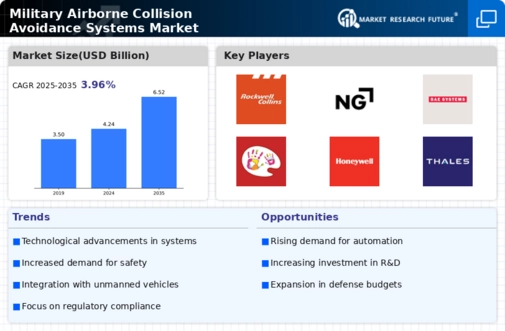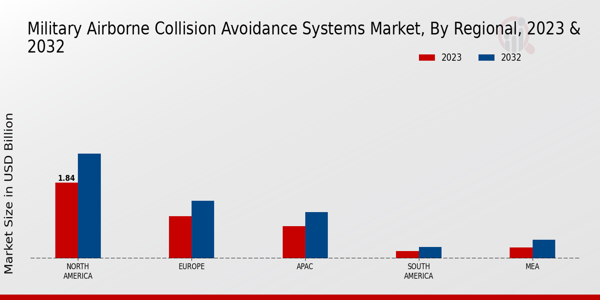Market Growth Projections
The Global Military Airborne Collision Avoidance Systems Market Industry is projected to witness substantial growth, with estimates indicating a rise from 4.24 USD Billion in 2024 to 6.52 USD Billion by 2035. This growth trajectory reflects the increasing recognition of the importance of collision avoidance systems in military operations. The anticipated CAGR of 3.98% from 2025 to 2035 underscores the ongoing investments in research and development, as well as the integration of cutting-edge technologies. As military forces around the world prioritize safety and operational efficiency, the demand for advanced airborne collision avoidance systems is expected to escalate.
Technological Advancements
Rapid technological advancements in avionics and sensor technologies are propelling the Global Military Airborne Collision Avoidance Systems Market Industry forward. Innovations such as artificial intelligence, machine learning, and enhanced radar systems are being integrated into collision avoidance systems, improving their accuracy and reliability. For example, the development of advanced algorithms allows for real-time data processing, enabling aircraft to make informed decisions to avoid potential collisions. As these technologies evolve, they are likely to enhance situational awareness for military pilots, thereby increasing demand for sophisticated collision avoidance systems, which are crucial for modern aerial operations.
Increasing Military Expenditure
The Global Military Airborne Collision Avoidance Systems Market Industry is experiencing growth driven by rising military budgets across various nations. Countries are prioritizing modernization and technological advancements in defense systems, leading to increased investments in airborne collision avoidance technologies. For instance, the United States has allocated substantial funds to enhance its air combat capabilities, which includes the integration of advanced collision avoidance systems. This trend is expected to contribute to the market's valuation, projected to reach 4.24 USD Billion in 2024, as nations recognize the importance of ensuring airspace safety and operational efficiency.
Growing Air Traffic and Congestion
The increasing volume of military and civilian air traffic is a significant driver for the Global Military Airborne Collision Avoidance Systems Market Industry. As airspace becomes more congested, the risk of mid-air collisions rises, necessitating the implementation of advanced collision avoidance systems. This is particularly evident in regions with high military activity, where the integration of military and civilian flight operations is essential. The market is projected to grow at a CAGR of 3.98% from 2025 to 2035, reflecting the urgent need for effective solutions to manage air traffic and ensure safety in increasingly crowded skies.
Regulatory Compliance and Safety Standards
The Global Military Airborne Collision Avoidance Systems Market Industry is influenced by stringent regulatory compliance and safety standards imposed by governments and international aviation authorities. These regulations mandate the adoption of advanced collision avoidance technologies to enhance flight safety and reduce accident rates. For instance, military organizations are required to adhere to specific guidelines that necessitate the integration of collision avoidance systems in new aircraft designs. This regulatory landscape is driving investments in the development and deployment of such systems, as military forces aim to meet compliance requirements while ensuring operational readiness.
International Collaborations and Partnerships
International collaborations and partnerships among defense organizations are fostering advancements in the Global Military Airborne Collision Avoidance Systems Market Industry. Joint exercises and shared research initiatives between countries facilitate the exchange of knowledge and technology, leading to improved collision avoidance solutions. For example, NATO member states often collaborate on defense projects, which include the development of integrated airspace management systems. Such partnerships not only enhance the capabilities of individual nations but also contribute to the overall growth of the market, as shared technologies and best practices are adopted across borders.




















Leave a Comment